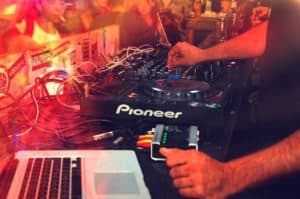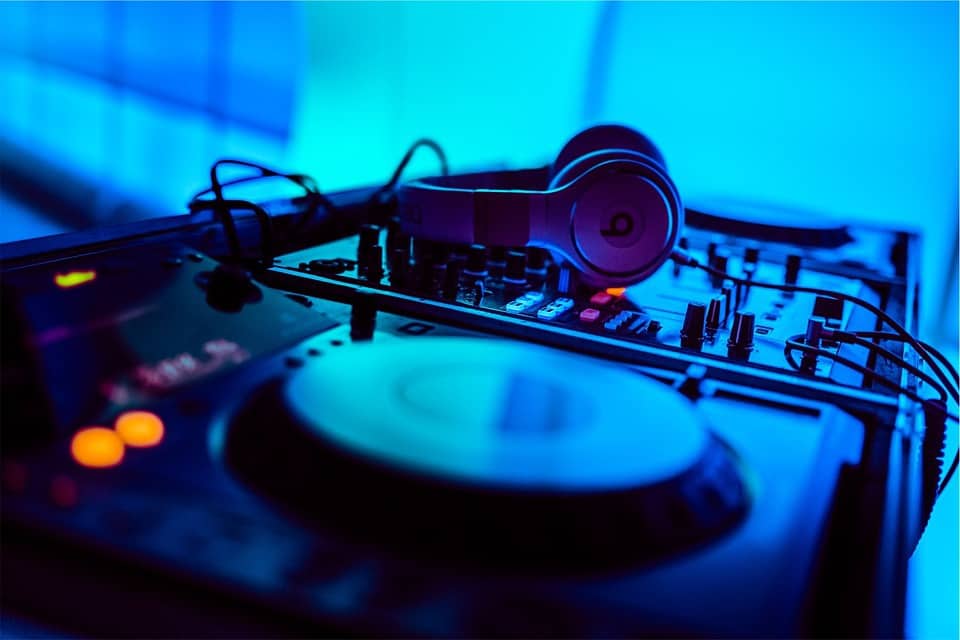
If you are a beginner DJ, walking up to a DJ booth and seeing a massive panel of buttons, knobs, wheels, flashing lights, and interactive software can be a little intimidating. If this is you, you definitely want to keep reading this, as we will be breaking down the DJ basics. This is the first lesson of our free DJ lessons!
Table of Contents
Setting up Your Studio
When you are first getting started as a DJ, you will probably be operating out of a bedroom or garage studio. There is no shame in this, as even the most experienced DJs don’t typically have a separate office.
You will need a place to store all of the equipment that you are going to acquire throughout your new career as a DJ, and you will want to select a place that is dry and climate controlled. Typically, a garage can be a good option, but it can be very risky to use if you live in a climate which reaches below freezing temperature (like humans, audio equipment can also freeze to death).
As long as it is a safe, secure, and stable place, you should be able to choose a suitable area to set up your new studio. We would recommend putting your studio in your room to give you plenty of more opportunities to practice and play with your equipment.
If you are looking to eventually create your own mixes and perhaps even produce your own tracks, you will especially want to consider making your studio indoors. Any DJ who also is considering being a producer will want to do more research on setting up the acoustics for a home studio or you will have a difficult time mastering your tracks.
Common DJ Setups
- The Traditional Setup
A traditional DJ setup features two vinyl turntables, a 2-channel mixer, a microphone, and some vinyl records to play music. This setup is where the craft of DJing began, and is not recommended for beginners who want to work as a mobile or club DJ.
A TON of practice will go into using this setup, but it can also be one of the most rewarding and impressive ways to DJ since it requires so much more skill than later setups. DJs who first used this setup were also the first ones to begin rapping over music, eventually creating American hip-hop music.
This setup is best for the DJ who wants to become a master of scratching. Although many different programs and software try to emulate the sound of a vinyl record scratch, nothing beats the sound of a real vinyl record.

- The CDJ Setup
This setup became popular after CDs took vinyl’s spot as the most used means of playing music. This setup is pretty simple, and only features two CDJ players, and some CDs.
If you want to have a setup that is reliable and doesn’t require a laptop or digital software to play music, this is a pretty solid option. Many of the newer CDJs offer features such as USB hard drive connectivity, and MIDI and timecode availability, allowing you to also use your CDJs as part of a hybrid setup.

- The Digital Setup
This setup is one of the more popular modern DJ setups since it is the easiest to transport and can still keep up with many of the most popular features. A digital setup can have an array of different items, but typically features one controller which takes the place of having two CDJs (or turntables) and mixer, as well as a laptop with DJ software.
People with a digital setup also will need to purchase an audio interface, DJ software, and of course all of the necessary cords and adapters to connect to your PA system. If you purchase the right equipment and know how to use it, even the most basic digital setup can compete with anybody else.

- The Hybrid Setup
A hybrid setup is great to consider when you want to have complete freedom to add in new pieces of equipment, change out individual parts of your setup, change software, and many other things while still using the latest technology.
This is the only setup which will allow you to do things like use one vinyl turntable, a MIDI controller, and perhaps even an external mixer or CDJ all in one setup. Remember that with the right supplies even things like turntables can be used with digital programs.
A hybrid setup will also use some sort of DJ software. There are many different options to consider when looking at DJ software, and several of these options are discussed in more detail below.

Essential Products
- Your Setup
Your basic setup is the first thing you should purchase and practice with. If you use any of the setups described above, you should have plenty of supplies for practicing before you branch out and start thinking about doing live events.
- PA System
At the very least, you will need two speakers to project your sound. There are two different types of speakers: active and passive.
To understand the difference between these two speakers we need to first understand what a power amplifier is. In short, a power amplifier is the mechanism which actually gives power to your speakers, without it you cannot play music through your speakers.
That being said, active speakers feature their own built in amplifier, and passive speakers require to you purchase a separate power amplifier. An amplifier can be a necessity which you can easily forget about while purchasing your setup.
Be sure to check out our Top 10 DJ Speakers for some guidance in picking your PA system.
- Mixer and/or Controller
If you are using a hybrid system you might want to consider getting both a mixer and a controller to give you plenty of controls to work with, and plenty of extra MIDI controls for you to personalize. DJs who do this will use the controller for things like cueing, playing, and adding FX to a track, and use a normal mixer for things like EQing, transitioning, and perhaps playing from an iPod or similar mp3 device when the need arises.
However, it is completely normal and professional to have just a mixer, or just a controller. For more information on how to use either of these we have created some free DJ lessons for you. If you would like to learn more about how to use a mixer, click here. If you want to learn more about how to use a controller, click here.
- Audio Interface (soundcard)
Unless you don’t use any digital equipment, or you have a device with a built-in soundcard, you absolutely need to purchase an audio interface. An audio interface allows you to project quality music, and make sure that you do not have any latency problems while playing your tracks.
In other words, a soundcard is what makes your music sound great, and ensures that you don’t have any problems with the music skipping. Another issue which is common to anybody not using an audio interface is that their software and controllers can freeze or lag really easily.
- Accessories
For things like adapters, speaker cables, microphones cables, speaker stands, power strips, extension cords, and so on, you will need to save plenty of room in your budget to purchase small things like this. If you need some guidance selecting your accessories, make sure to see our Top 10 DJ Accessories.
Getting Started: The Very Basics of Mixing
If you set up your equipment correctly, you should be able to play two (or more) songs at the same time, depending on how many channels you have on your mixer. Be sure the crossfader is positioned in the middle, otherwise you might only hear one track.
When you are listening to two songs at once, you will quickly notice that one song plays faster than the other. If you are using DJ software, all you will have to do to make these songs play at the same pace will be to click the “sync” button, or use the tempo fader to match the BPMs of each track.
Typically dance music harbors as low as 80 BPMs all the way up to 140. You will soon notice that most of your dance music library is either around 90 BPMs or 130 BPMs, this is pretty typical.
As you play around with the equipment, you should soon be able to easily make two songs play together at the same speed. With practice, you will be able to use this technique to make your song transitions flawless and clear.
Don’t Forget to Practice!
Now that you own a DJ setup and understand the DJ basics, it is your duty and responsibility to practice it, or you will simply never become good at it. Once you pick the type of setup you want, purchase your speakers, and learn how to match two songs together you are well on your way to becoming a professional DJ.
Click to Continue to the Free DJ Lesson #2: How to use a DJ Mixer
